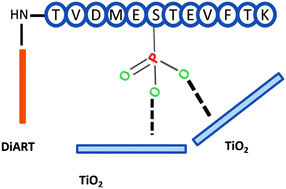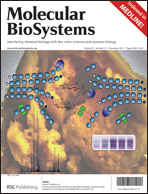Cost-effective isobaric tagging for quantitative phosphoproteomics using DiART reagents†
Abstract
We describe the use of an isobaric tagging reagent, Deuterium isobaric Amine Reactive Tag (DiART), for quantitative phosphoproteomic experiments. Using DiART tagged custom mixtures of two phosphorylated peptides from alpha casein and their non-phosphorylated counterparts, we demonstrate the compatibility of DiART with TiO2 affinity purification of phosphorylated peptides. Comparison of theoretical vs. experimental reporter ion ratios reveals accurate quantification of phosphorylated peptides over a dynamic range of more than 15-fold. Using DiART labelling and TiO2 enrichment (DiART-TiO2) with large quantities of proteins (8 mg) from the cell lysate of model fungus Aspergillus nidulans, we quantified 744 unique phosphopeptides. Overlap of median values of TiO2 enriched phosphopeptides with theoretical values indicates accurate trends. Altogether these findings confirm the feasibility of performing quantitative phosphoproteomic experiments in a cost-effective manner using isobaric tagging reagents, DiART.


 Please wait while we load your content...
Please wait while we load your content...